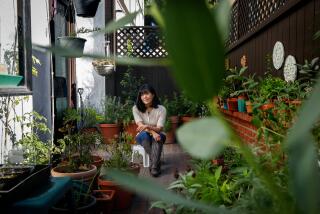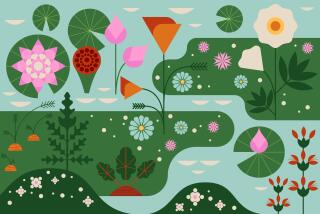Garden Jargon
- Share via
If a gardener says he or she is going to “dead-head” this weekend or talks about “potting up,” what exactly is going on?
Gardeners have their own vocabulary, words that may not even be in the dictionary. Some are familiar but have other meanings unique to the world of growing things. Here are a few:
allee n: French. swath of lawn, path or road with overhanging trees on each side. A classy way to focus attention in grand gardens.
amendment n: any material added to a soil to make it better, usually an organic material or mix of materials, like ground bark and peat moss, that physically improves a soil. Gypsum is an example of an amendment that chemically improves soils. Some have nutrient value, but should not be confused with fertilizer.
annual n: plant that lives for only one season, propagating by setting seed.
bed n: area in a garden where certain plants are grown (a bed of annuals) and that typically requires more than ordinary work, so unlike the piece of furniture designed for repose.
bedding out v: to set out bedding plants.
bedding plant n: any plant sold by nurseries that is meant to be planted in quantity for only one season. Usually refers to annuals but may include perennials that are grown for only a season and then taken out.
bolt v: when a plant stops making leaves and suddenly sends up a seed stalk, as when lettuce bolts and turns bitter.
border n: any long bed, usually a perennial border, the classic English contrivance in which perennials are massed together in tiers.
botanical name n: the proper Latin scientific name, italicized in text. Because many plants share common names, botanical names are more accurate for identification.
broadcast v: to scatter seed.
bud union n: the bulge at the base of roses and deciduous fruit trees, where a bud from one variety is grafted onto the rootstock of another.
compost n: organic material that is left, or made, to rot, usually in a pile. In England, compost can also be any potting soil or amendment; this confusion is spreading to the U.S., where many organic products are being called composts, although compost usually contains rock dust and other nutrients and is more like a fertilizer than an amendment.
compost v: to make compost.
cross n: a plant with dissimilar parents.
crown n: the base of a plant, where roots meet stem. A critical area very susceptible to water-induced diseases. Many gardeners plant so the crown is a little higher than the surrounding soil so it does not get too wet. It is also a good idea to keep mulches away from the crown.
cultivar n: a selected variety found in a garden (a “cultivated variety”) usually propagated by cuttings, so it is identical to its parents. In gardening publications, cultivar names often are printed in single quotation marks: ‘Wheeler’s Dwarf.’
cutting n: a section of stem (usually several inches of the tip) that is cut off; its lower leaves are removed, and it is partly buried in sand so it will form roots.
cutting back v: removing the dead or unsightly foliage on perennials in winter.
dead-head v: to remove spent flowers from plants to keep them blooming longer. For dead-heading, some gardeners let a thumbnail grow long enough to act as a tiny shear when pressed against a forefinger.
dibble n: a small tool used for transplanting or pricking out seedlings.
disbud v: to remove flower buds from clusters so the remaining flowers grow larger. Gardeners often remove the largest central bud from floribunda roses, so the rest make a larger spray.
divide v: to separate clumps of plants into smaller, plantable pieces. Some perennials require dividing as their centers grow old and die or stop flowering.
double dig v: the preferred way to prepare soil in vegetable beds and perennial borders. To double dig, first remove a row of soil (reserving it for the last row), then loosen and add amendments to the soil underneath. The upper soil from the next row is turned, amended and put in the previous row. The soil underneath is then improved. And so on.
drainage n: refers to the movement of water through a soil. Good drainage means water moves easily downward and the soil does not become soggy, which is fatal to many plants. Adding organic amendments, gypsum or even sand separates soil particles and improves drainage; so does elevating the soil.
drift n: a long irregular planting, as a drift of daffodils.
elevate v: to raise a plant and its soil in a raised bed or on mounded soil so the sensitive crown area is above the general soil level, ensuring that it does not get soggy.
eye n: a not-yet-active and barely visible bud.
fertilize v: 1. to give a plant fertilizer or plant food, by scattering, spraying or otherwise distributing. Used interchangeably with “feed,” though some horticulturalists object to the latter because fertilizing is more specific, referring to the fact that you are improving the fertility of the soil, not directly “feeding” the plant. 2. to apply pollen to a flower’s pistil, in order to get seed.
fertilizer n: material that primarily provides nutrients to plants. Refers to both organic fertilizers, made from natural materials, and manufactured chemical fertilizers.
flat n: shallow tray holding many plants.
foliar feeding v: applying fertilizers that can be absorbed through the leaves. Though the effect is quick, it is short-lived.
fungus n: neither plant nor animal, but a simple organism lacking chlorophyll, including mushrooms, molds, rusts and yeasts. Many are involved in plant diseases, such as powdery mildew, root rot or fusarium wilt on tomatoes.
green manure n: a plant that is grown, then tilled into the soil to add organic matter and nutrients.
hardening off v: letting plants become accustomed to a new environment, as the gradual moving of seedlings from indoors to out.
hardiness n: a confusing term, usually meaning the amount of frost a plant can take in a given locale. For instance, a plant might be hardy in England but not in Boston. Of little importance except in California’s high desert and mountains.
heirloom n: older, open-pollinated varieties that are preserved and handed down.
hybrid n: cross between two varieties of the same plant. For a plant to be sold as an F1 hybrid (which stands for “first filial generation”), the parents must be known and the pollination process carefully controlled so that the resulting offspring are very similar. Although F1 hybrids are usually more vigorous, their seeds will not produce similar plants, so there is no point saving them.
lace v: to thin out a tree so that it retains its natural grace and lets in more light.
liner n: young nursery plant being grown in its first container.
mulch n: material used to cover the ground around plants to prevent evaporation and weed growth.
native n: plant that grew naturally in a region before humans altered the landscape.
naturalize v. 1: to plant in a natural, random fashion. 2: what plants do (with no help from the gardener) when they are comfortably at home in a garden, reproducing and spreading by seed or offsets.
node n: the joint in the stem where leaves sprout.
nutrient n: an element required by plants. Nitrogen (N), phosphorus (P) and potassium (K) are the three most important and are listed on a fertilizer package as percentages (such as an N-P-K of 10-6-6). There are also micronutrients required in less quantity, such as magnesium and iron, that are deficient or unavailable in many soils.
open-pollinated n: varieties that naturally cross and remain true to type so the seed can be saved.
over-pot v: to move a plant into too large a container.
perennial n: plant that lasts more than a season but never quite becomes woody like a shrub. Herbaceous perennials are those that die down each winter.
pinch back v: to nip off the very end of a shoot, stimulating the growth of more branches below. It makes many plants bushier and more floriferous.
potager n: a vegetable garden laid out in a formal pattern.
pre-plant n: fertilizer added to the bottom of a hole before planting, usually a good idea because many nutrients do not move through the soil to the roots, where they are needed.
pricking out: v: gently digging up a tiny seedling and moving it to a larger container.
raised bed n: any plant bed that is purposely mounded or elevated, usually to improve drainage.
remontant n: a plant that flowers more than once a year.
repot v: to move up in pot size; the English call it potting up.
root-bound adj: condition of plants left in a container too long. Unless such roots are untangled at planting time, plants will have a hard time becoming established in the garden.
set out v: to plant annuals or vegetables from flats or packs into the garden.
side dress v: to add fertilizer in a band next to plants.
slip n: a cutting.
soil n: what gardeners call dirt, once they have gotten their hands in it.
spit n: a wonderful English term for the depth of a spade.
stake v: to support a plant with bamboo poles, wooden stakes or metal supports.
standard n: a shrub grown like a small tree, with a clearly defined trunk.
sucker n: sprout that arises from the roots. Usually applies to roses when sprouts from the rootstock (below the bud union) grow. Remove them.
systemic n: a chemical (such as an insecticide or herbicide) that is absorbed by the roots or leaves of a plant and distributed throughout the plant. Never use systemics on edibles.
thatch n: the dead material at the base of grass.
top v: to cut back only the tops of trees; a bad idea because it encourages weak and dangerous growth.
trace elements n: minor nutrients essential to plant health. Plants often show the lack of these nutrients by becoming chlorotic, the condition characterized by green veins and yellowing leaves.
transplant n: a plant that has been, or will be, moved into a larger container or into a garden bed.
virus n: an intracellular and generally incurable plant disease. Viruses can be transmitted by such sucking insects as aphids. Removal of diseased plants is the only remedy.
whip n: a young tree with no side branches.
weed n: any plant in the wrong place.






